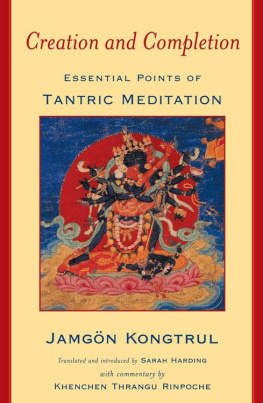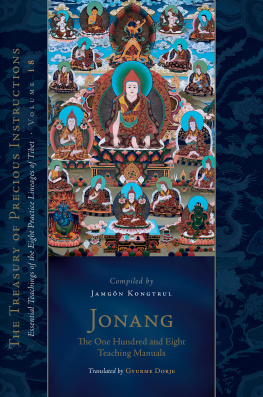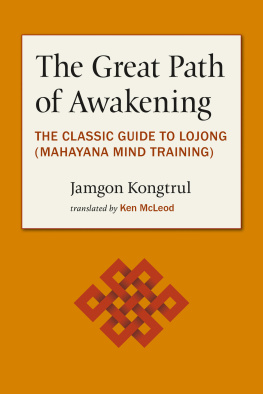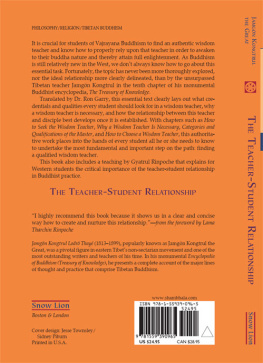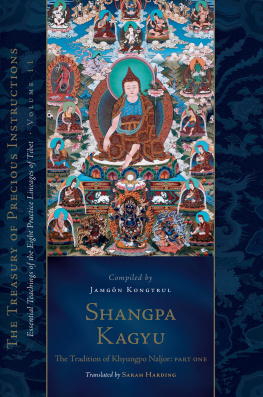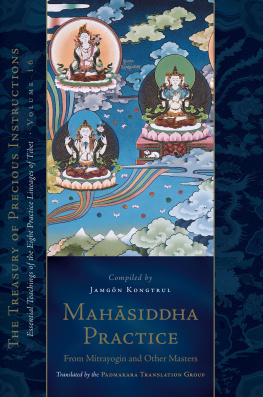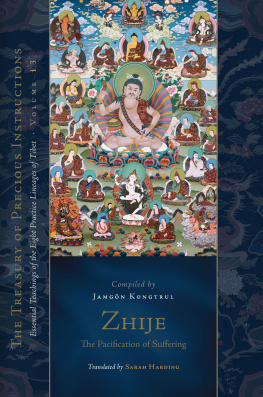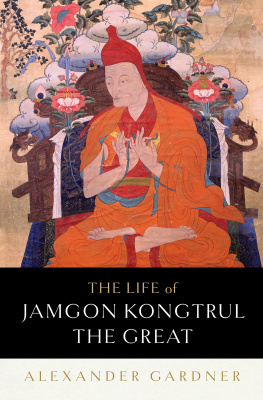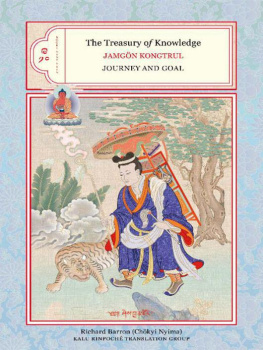Creation & Completion

Walk the path of tantrafrom creation to completion.
C reation and Completion represents some of the most profound teachings of Jamgn Kongtrul (1813-99), one of the true spiritual and literary giants of Tibetan history. Though brief, these teachings offer a lifetime of advice for all who wish to engage inand deepena tantric Buddhist meditation practice.
The original text, beautifully translated and introduced by Sarah Harding, is further brought to life through an in-depth commentary by the contemporary master Thrangu Rinpoche. Key Tibetan Buddhist fundamentals are quickly made clear, so that the reader may confidently enter into tantras oft-misunderstood creation and completion stages.
In the creation stage, practitioners visualize themselves in the form of buddhas and other enlightened beings in order to break down their own ordinary concepts of themselves and the world around them. This meditation practice prepares the mind for engaging in the completion stage, where one has a direct encounter with the ultimate nature of mind and reality.
Kongtruls writings shine with lucidity and transparency.
Sarah Harding has rendered a great service.
Ken McLeod, author of Wake Up to Your Life
An excellent book.
Religious Studies Review
Creation and completion meditation is the cornerstone of tantric Buddhist practice and draws upon a rich array of techniques and presumptions relating to moral cultivation. This book will be of great interest to both scholars and practitioners of tantric Buddhism.
Janet Gyatso, Hershey Chair of Buddhist Studies, Harvard University

KHENCHEN THRANGU RINPOCHE is one of the most highly respected lamas of the Kagyu lineage with students around the world. The author of many books, he is the senior tutor to His Holiness the Seventeenth Karmapa, Ogyen Trinley Dorje.

SARAH HARDING has been a Tibetan Buddhist translator and practitioner since 1974. She is the author of The Life and Revelations of Pema Lingpa. She has served for twenty-two years as a faculty member at Naropa University in Boulder, Colorado.
Contents

For Translators
Under the Spiritual Authority of
Khenpo Tsultrim Gyamtso Rinpoche
The end of this twentieth century is a time when people are extremely busy, whether engaged in their work, family, or assimilating a constant stream of new information. Finding a place for the practice of Dharma within such a complex and demanding world is not always easy, and so there is a need for clear, succinct presentations of meditation theory and practice.
This distillation of essence requires the most accomplished master, one who not only knows deeply a vast range of texts, but who has also realized the meaning of which they speak. Jamgn Kongtrul Lodr Thaye was such a master. One of Tibets greatest scholars, he was also a realized siddha, who through his compassionate desire to benefit sentient beings, composed this text on the central forms of practice within the Vajrayana, the creation and completion stages of meditation. There is an almost uncountable number of texts dealing with these topics, too many for any one person to study or practice, and so this text summarizing the key points is extremely useful. For new students, who do not know where to turn, it leads the way along a direct and clear path; and for old students, it gathers into one place and codifies the main points of myriad explanations.
Several years ago I suggested to Sarah Harding that she translate this composition, and I am very glad to see her work brought to completion. May it be the cause of immense benefit for sentient beings limitless in number.

Khenpo Tsultrim Gyamtso Rinpoche
Post Box 4017, Kathmandu. Nepal.
WHILE IN RETREAT from 1976 to 1980, I started reading Tibetan texts on the subject of visualization in an attempt to understand what it was that I was supposed to be doing, and why. There is a wealth of information in Tibetan, and my research proved to be rewarding and reassuring. Since the retreat, Ive met many Western students of Tibetan Buddhism doing visualization practice but without the benefit of explanation. Although there is surprisingly little inquisitivenessa sign, no doubt, of great faithI felt a desire to help fill this gap in the transmission of the Dharma. In 1987, I translated a short text (bskyed rdzogs nyams len mdor bsdus kyi gtam) of uncertain origin on this subject to use as a teaching text. During this work, I asked Khenpo Tsultrim Gyamtso Rinpoche and his assistant Tenpa Gyaltsen for clarification on certain points. At that time, Khenpo Tsultrim introduced me to this text by Jamgn Kongtrul (bskyed rdzogs gnad bsdus; Creation and Completion) and suggested that I translate it. I found it listed in two separate tables of contents of Kongtruls collected works as being located in volume cha of the Treasury of Vast Precepts (rgya chen bka mdzod). However, the diligent efforts of Susan Meinheit at the Library of Congress, and my own search through the library of the late Chgyam Trungpa Rinpoche, failed to turn up the actual pages. Later, information from Khenchen Thrangu Rinpoche revealed that this text had been missing (borrowed was the word) from the original volumes when the more recent woodblocks were being produced. So all that came into my hands was the mysterious photocopy from Khenpo Tsultrim.
It sat on my desk for years. In 1990, during a time of intense personal crisis, I turned for some reason to this text for refuge, translating furiously for several weeks. At the time I thought that if I could have only one book on a desert island, it would be this one. I reworked it over several years, asking questions of whatever generous and learned lama passed my way. In this regard, I would like especially to mention Bokar Rinpoche, successor to Kalu Rinpoche and holder of the Shangpa lineage, Khenpo Dny Rinpoche, Khenchen Thrangu Rinpoche, Khenpo Palden Sherab Rinpoche, and Khenpo Tsultrim Gyamtso Rinpoche. In checking the translation with the original, Tulku Thondup Rinpoche and Lobsang Lhalungpa were extremely generous. And in reading the English translation and the introduction, Dr. Reginald Ray, Joey Townsend, and Fletcher Chamberlain offered useful suggestions and encouragement. There were many others who contributed one way or another. I thank them all. Finally, with the support of Constance Miller and Emily Bower at Wisdom, it has at last reached some form of completion. In the translation of such a profound teaching, the work of improvement could have continued on for much longer, perhaps forever. But it seems time to share it with others, according to the original intention, and accept responsibility for any errors or mediocrity, praying that the original power comes through despite such failings. The effort is dedicated to the continuing beneficial influence of the activities of the great Kyabje Kalu Rinpoche.
Next page
